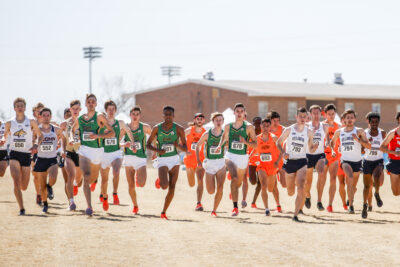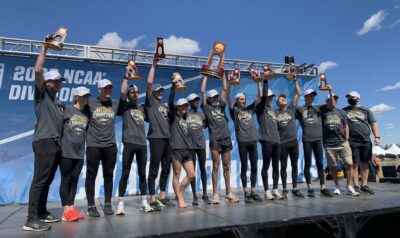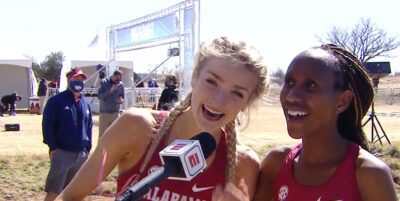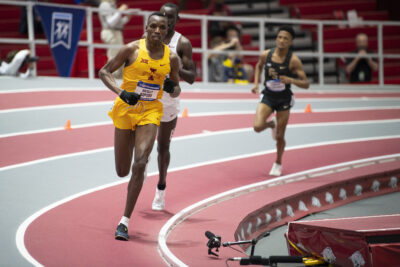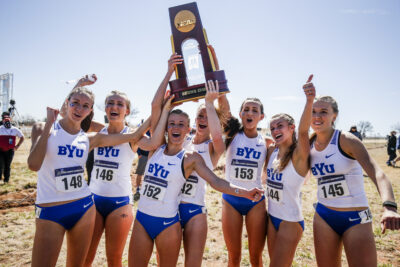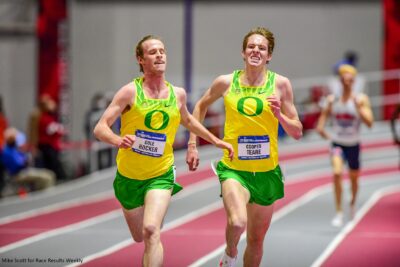Loaded Teams, New Additions, & The Impact of NIL: Your Guide to the 2021 NCAA Cross Country Season
By Jonathan Gault
September 23, 2021
Barely six months have passed since the last NCAA Cross Country Championships and another season is upon us. Most every school in the country has already raced at least once this fall, and things are going to get serious pretty soon. We’re three weeks away from Nuttycombe/Pre-Nats weekend, five weeks from conference weekend, and eight weeks away from NCAAs, which will be held at Apalachee Regional Park in Tallahassee on November 20 — the first time ever that the Big Dance has been held in Florida.
Some elements of the 2021 season will be resemble the 2020-21 season that preceded it. Because of COVID uncertainty, the NCAA did not count last season against any athlete’s eligibility clock, meaning a huge chunk of schools are returning six or even all seven of their top seven from a year ago. All the teams that shined at NCAAs in March — NAU, Notre Dame, BYU, NC State — are loaded again this fall.
But in many ways, this season will be completely different from last season, a campaign that lasted six months, saw entire conferences abandon their seasons (welcome back, Ivy League!), and forced top programs and athletes to choose between indoor track and cross country — or attempt an audacious double. This time, XC has the spotlight to itself.
“There’s a level of excitement starting cross country and bringing cross country back to the fall season,” says BYU women’s coach Diljeet Taylor. “It almost is a ‘Happy New Year’-type mentality. That’s what I’m saying when I see coaches.”
What else is new? Glad you asked. After speaking with over a dozen coaches over the last two weeks, here’s what you need to know about the 2021 season.
Everybody’s loaded
A common trend emerged in my calls with NCAA coaches: almost everyone believes their team will be better than it was in 2020-21. And why shouldn’t they? Their squads are older and more experienced than a year ago, with a spring and summer’s worth of training gains. Some athletes chose to graduate rather than come back for a fifth or sixth year at their school, but most teams will return more of their runners than in a typical year. Which means that it will be harder than ever to crack the podium.
“The depth of the field is going to be crazy the next couple years, because instead of having five classes, you’re going to have six classes of depth,” says Minnesota coach Sarah Hopkins, whose women finished 5th at NCAAs last year and will be led in 2021 by Bethany Hasz, a sixth-year senior. “Usually by the time kids get really good, hopefully they’re on their way out. And now you’ve got those kids for one more year. So I think you are going to see some pretty impressive performances across the board.”
Winning it all is going to be tough as hell (as if it wasn’t already). Last year, Notre Dame put six men in the top 36 and scored just 87 points (admittedly that still lost to NAU by 27) and they are bringing back their entire top six an adding in 13:41 guy Matthew Carmody. The Lumberjacks did lose two top-10 finishers in Blaise Ferro and Luis Grijalva, but they are adding in Big 10 champ George Kusche from Nebraska. And OK State coach Dave Smith, whose team was third a year ago, believes this year’s squad has the potential to be his best ever — high praise from a man whose coached three NCAA title teams, including a 2012 team that scored 72 points at nationals.
Is the sport too top-heavy?
Over the last 10 years, five men’s teams have finished on the podium four or more times: NAU (8), Colorado (7), BYU (5), OK State (4), and Stanford (4). Collectively, those five schools account for 70% of the podium appearances during that span. One of the schools to crack that monopoly recently is Notre Dame, who finished second in 2020 just four years after finishing 14th at the Great Lakes Regional. Now that his program has reached the ranks of the elite, ND coach Sean Carlson is doing everything he can to stay there because he only sees the divide widening between the sport’s haves and have-nots.
“It seems like the powers are just becoming superpowers,” Carlson says. “In recruiting right now, when I call a kid, that kid is talking to one of probably [the same] six schools, almost guaranteed. I don’t hear a lot of other schools in that picture. Right now, it just seems to me that the rich are getting richer. I certainly don’t think the podium at cross country nationals is going to get any easier. I think it’s going to be really tough over the next couple years.
“If you don’t have an embarrassment of riches these days, you’re gonna be in a tough spot. And what does that allow these bigger programs to do? It just gives them a bigger margin for error.”
So I put the question to Dave Smith, who follows this sort of stuff closely. Is the sport top-heavy right now?
“It’s accurate, but it’s been that way for 40 years, ever since we went to regional qualifying,” Smith says “…Some teams cycle in, some teams cycle out, but once you start winning, you get this recruiting advantage where athletes identify you as a place they want to go.”
Indeed, the last 48 men’s NCAA championships have been divided between just 11 schools. Compare that to 22 different NCAA champions in men’s basketball, 22 in football, and 23 in soccer over the same span. NAU, Colorado, BYU, OK State, and Stanford may have dominated the podium over the last 10 years, taking 70% of the available spots, but the 10 years before that wasn’t much different as Wisconsin, Stanford, Iona, Colorado, and NAU combined to take 65%.
On the women’s side, the titles and podium appearances have been more evenly spread. Only two schools had 4+ podium appearances over the past decade (New Mexico had five, Stanford four), and the last 11 titles have been divided across nine different schools. Why the disparity? The scholarship difference (12.6 for men’s track & field/XC programs, 18 for women) may have something to do with it, as it gives programs more recruiting power and keeps more track-focused programs relevant.
Who’s new?
The top 10 women’s individuals at NCAA XC in Tallahassee figure to look pretty similar to the top 10 from Stillwater in March as there aren’t a ton of new faces primed to make an immediate impact (though keep an eye on Northern Arizona’s Stephanie Cotter, a transfer from Adams State who won the 2019 NCAA DII title by 24 seconds).
| 2020 NCAA XC Women’s Top 10 1 Chelangat, Mercy JR-3 Alabama 20:01.1 2 Roe, Taylor SO-2 Oklahoma State 20:06.7 3 Tyynismaa, Amaris SO-2 Alabama 20:10.2 5 Steelman, Hannah SR-4 NC State 20:14.9 6 O’Neill, Taryn JR-3 Northern Arizona 20:23.0 7 Allen, Summer SR-4 Weber State 20:23.3 8 Hasz, Bethany SR-4 Minnesota 20:25.2 9 Chmiel, Kelsey SO-2 NC State 20:26.4 |
2020 NCAA XC Men’s Top 10 1 Mantz, Conner JR-3 BYU 29:26.1 2 Wildschutt, Adriaan JR-3 Florida State 29:48.2 3 Kiptoo, Wesley JR-3 Iowa State 29:54.9 4 Young, Nico FR-1 Northern Arizona 29:58.3 7 Nur, Abdihamid SO-2 Northern Arizona 30:05.3 8 Rodriguez, Isai JR-3 Oklahoma State 30:08.3 10 Kilrea, Danny JR-3 Notre Dame 30:11.5 |
It’s a different story on the men’s side. Oregon’s Cooper Teare didn’t run XC last year, but given that he ran 13:12 to win the NCAA 5k last spring and finished fourth at the Olympic Trials, he should challenge for the title in November. And Alabama has brought in a pair of Kenyans, Hillary Cheruiyot and Victor Kiprop, who could be difference-makers. Alabama lists Cheruiyot’s pb as 13:27 and Kiprop’s 13:26, and while coach Dan Waters says Cheruiyot’s time is more of an altitude conversion than an official pb — “he’s more like a 13:40 guy” — Kiprop’s time is legit. He actually ran 13:26 — at altitude in Nairobi.
Teare’s former teammate Cole Hocker will not be back for the Ducks as he elected to turn pro, but fellow 1500m Olympian Yared Nuguse of Notre Dame, who was 23rd at NCAA XC last year, is back for his fifth year at ND.
A couple of other names to remember:
- Graham Blanks, a native of Athens, Ga., will be a redshirt freshman at Harvard this fall. Last spring, one month after his 19th birthday, he ran 13:27 for 5,000 meters.
- Kieran Lumb, a Canadian who ran 13:24 in April, is now running for the University of Washington.
A new Wesley Kiptoo?
Iowa State’s Wesley Kiptoo was a revelation last season. Sporting his trademark gloves no matter the weather, Kiptoo ran the same way a 10-year-old plays FIFA, madly mashing the turbo button until it runs out and coasting home on the fumes. It produced some fantastic results — notably a 13:23.77 meet record to win the NCAA indoor 5k after a 59.79 opening 400 — but the effectiveness waned over time. At NCAA XC, that 13:23 from three days earlier and a 2:31 opening kilometer took their toll over the final miles as Kiptoo faded to third place. By the NCAA outdoor champs in June, Kiptoo was cooked, finishing 11th in the 10k and 13th in the 5k.
Kiptoo’s coach Jeremy Sudbury says there can be an adjustment period for a juco star like Kiptoo once they start racing the heightened competition of NCAA Division I. Talent alone is no longer enough to win.
“Wesley is incredibly strong and loves to front-run,” Sudbury says. “That’s who he is, his DNA, his personality. As a coach, you don’t want to stifle that, but you want to help him and manage it maybe a little bit more efficiently.”
This offseason, Sudbury has worked closely with Kiptoo on some of the finer aspects of racing. One of their key discussions has centered on energy management, both during a race and throughout the season.
“A talking point is evaluating when to make those [big moves],” Sudbury says. “Do you make those at the beginning of the race and try to get separation? Or is that something that you lay in the weeds and make later in the race and you’re able to make your decisive move then?
“Looking at the sheer volume of racing he had last year, it was hard to get Wesley to understand that you can’t go out and run as hard as he he did all the time…You don’t need to break every course and [instead] maybe try to set it up so that in the postseason, that’s when you’re really trying to break the records.”
Will the balance of power shift at all in the ACC?
In recent years, the powers in ACC cross country have been clear: Syracuse and Notre Dame on the men’s side, NC State on the women’s. But in the last two years, three NCAA-title winning coaches have taken over ACC programs: Vin Lananna at Virginia, Chris Miltenberg at North Carolina, and Eric Heins at Louisville (Heins is the distance coach, while the other two occupy the director position).
The most tangible progress so far has come in Chapel Hill. Last year, the UNC women finished 14th in their first NCAA appearance since 2014. They’re currently ranked 13th in the coaches’ poll, with the men (who haven’t made nationals since 2014) ranked 23rd. The Tar Heels also brought in a big 2021 recruiting class, securing Judson Greer (8:49 3200), Sully Shelton (8:50 3200), and Parker Wolfe (8:43 2-mile, Gatorade national XC runner of the year) on the men’s side and Brynn Brown (9:39 3200) and Sydney Masciarelli (10:04 2-mile, 2018 Foot Locker champ) on the women’s side.
With Lananna and Miltenberg both in their third year (Heins was only hired in March), I’ll be curious to see how those programs fare this fall.
The NCAA’s new NIL rules haven’t had much of an impact…yet
On June 30, the NCAA adopted a new policy allowing athletes to capitalize on their name, image, and likeness (NIL) while retaining collegiate eligibility. In larger sports like football, the money began flowing immediately: by the end of July, Alabama quarterback Bryce Young had secured over $800,000 worth of sponsorships. The impact on cross country was…less significant.
Of the 17 coaches LetsRun spoke to for this story, only two — Dan Waters of Alabama and Laurie Henes of NC State — said they were aware of an athlete on their team who had signed an NIL deal. A significant domino fell on Tuesday, however, when it came out that every female athlete at BYU will have the chance to earn up to $6,000 each through a deal with Provo-based company SmartyStreets (this news broke after our interview with BYU coach Diljeet Taylor).
MB: All BYU women’s athletes offered $6,000 NIL deal including walkons…
Since coaches are not allowed to facilitate deals and NIL regulations vary by state, there is a lot of uncertainty at the moment.
“I think every coach right now, we’re just trying to figure out, how does this all shake out?” says NAU’s Mike Smith.
The track athletes who may benefit most are those with large social media followings. A million followers on Instagram or TikTok is more appealing to a sponsor than a 28:00 10k pb.
Then there’s the elephant in the room.
“We haven’t seen yet any shoe companies step into that picture in NCAA running,” says Notre Dame’s Carlson. “If that happens, then floodgates can open.”
To be legal under the NCAA guidelines, NIL deals can’t be “pay-for-play” — which means they cannot include bonuses for winning certain races or running certain times. But New Mexico coach Joe Franklin says it wouldn’t take much work to ensure a typical pro contract meets the guidelines.
“They’re deemed marketing contracts or endorsing contracts,” Franklin says. “If the performance bonuses were gone, they may actually be legal.”
The question, though, is whether any shoe company will take the leap. Brands like Nike, adidas, and Under Armour already have deals with school athletic departments. If you’re Nike, why would you pay individual Oregon athletes to wear your shoes when you already pay the athletic department for the same thing? And if you’re adidas, is there a benefit to trying to pay an athlete at a Nike school to wear your shoes? Even if their athletic department approved of it, their singlet and shorts would still bear the Nike logo.
Theoretically, if a brand really wanted to lock up a potential megastar — a Sydney McLaughlin or Cole Hocker type — they could try to beat out the competition by securing their rights as a collegian and engendering goodwill when it comes time to sign a long-term, fully-professional contract. But even if a scenario like that comes to fruition, it may affect only one or two athletes per year. Is it worth the investment in a sport that produces so few genuine stars?
“I look at how sparse the money is professionally in track and field and I don’t think the [shoe companies] are going to just jump all-in on it off the bat,” says Arkansas coach Chris Bucknam.
The pandemic and the transfer portal have changed recruiting
We may be back to a normal schedule of competition this fall, but COVID’s effects on NCAA cross country will be felt for several years. Because the 2020 cross country season did not count for eligibility purposes, many schools will be carrying six classes’ worth of athletes for the next five seasons as opposed to the usual five. The NCAA did make things easier for this season, ruling that any seniors returning in 2021 for whom 2020 would have been their final season will not count against the scholarship limit (though schools are still on the hook for paying out those extra scholarships). But until the system resets in the fall of 2026 (when the high school classes of 2020 and 2021 will have completed their final year of eligibility), it will be tougher than usual for coaches to allocate scholarships.
Of course, this affects every program differently. Some coaches said their recruiting and scholarship decisions didn’t change much due to the pandemic, but for others it had a significant effect. COVID cancellations meant there were fewer results to evaluate for athletes in the high school class of 2021, and with no official visits last year, coaches were not able to get a sense of how individual athletes would fit into their program. Carlson says he did not recruit as many athletes as normal in the class of 2021, in part because he already had money tied up in his current roster but also because he wasn’t sure what he was getting.
“I didn’t want to invest in guys you just didn’t really know exactly what they are,” Carlson says. “COVID, it’s an unfortunate situation, but I just wasn’t willing to take those risks.”
COVID isn’t the only thing affecting high school recruiting. The NCAA transfer portal — a database of athletes looking to transfer that every NCAA school has access to — has made it easier than ever to patch up holes on a team. And that has a trickle-down effect on high school athletes. There is more certainty in recruiting a transfer with a history of NCAA success than a high schooler who has never run a collegiate race.
“The portal stuff has impacted the high school recruit or maybe lessened the value of the high school athlete just a little bit unless they truly are a superstar that can come right in and help you,” says Iowa State coach Jeremy Sudbury.
Arkansas’ Bucknam says the portal has also influenced his recruiting.
“You want to have some money in reserve that, if something comes across your desk [about an athlete in the portal], you want to be able to move on them,” Bucknam says.
The program that benefited the most from transfers this season may be Colorado. On the women’s side, Colorado’s #1 (Abby Nichols), #4 (Micaela Degenero), and #7 (Rachel McArthur) runners from NCAAs last year were all transfers, and the Buffaloes added the top transfer in the country in Michigan State’s India Johnson (35th at NCAA XC). On the men’s side, four of Colorado’s top five at the Cowboy Jamboree last weekend were transfers. Stephen Jones transferred from Mississippi State in 2020, while Brendan Fraser (Notre Dame), Andrew Kent (Georgia Tech), and Charlie Sweeney (Western Colorado) all joined the Buffs over the summer.
